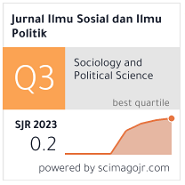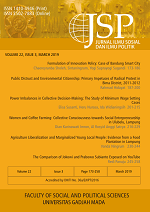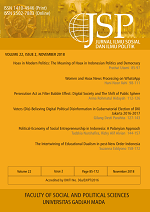Gender-Equality Concerns and Political Attitudes toward Women in the 2019 Legislative Election: Evidence from Pelalawan
Andhik Beni Saputra(1*), Azhari Setiawan(2), Citra Puspita Febriani(3)
(1) Department of Government, Universitas Abdurrab, Riau, Indonesia
(2) Department of International Relations, Universitas Abdurrab, Riau, Indonesia
(3) Department of Government, Universitas Abdurrab, Riau, Indonesia
(*) Corresponding Author
Abstract
The presence of women in Indonesian politics remains underrepresented whereas cultural and societal aspects pose critical influence in determining voter behavior toward female candidates. The aim of this article is to examine voter behavior regarding female candidates and the probability for them to be elected as members of parliament. We apply quantitative method by developing three models representing three combinations of predictor variables, (i) socio-demography, (ii) gender- equality concern, and (iii) political attitude towards female candidates as determinants towards female candidate electability. The study took place in Pelalawan Regency in Riau Province, by analyzing 400 respondents with equal numbers of men and women from various socio-economic backgrounds through clustered random sampling method. We tested these hypotheses and our three models by utilizing logistic regression analysis. The result shows that political attitude toward female candidates (Model 3) are the strongest coefficient and most significant determinant for female candidate electability. The study also revealed that female candidate’s electability in Pelalawan Regency is lower than male candidate’s electability among male respondents. On the other hand, female candidate’s electability is higher than male candidate’s electability among female respondents. Moreover, we also found that education determines female candidate’s electability where the more educated an individual is, the more he/she tends to vote for female candidates.
Keywords
Full Text:
PDFReferences
Alexander, A. C. (2012). Change in Women’s Descriptive Representation and the Belief in Women’s Ability to Govern: A Virtuous Cycle. Politics & Gender, 8, 437– 464. https:// doi.org/10.1017/S1743923X12000487
Alexander, A. C., & Welzel, C. (2011). Islam and patriarchy: how robust is Muslim support for patriarchal values? International Review of Sociology-Revue Internationale de Sociologie, 21(2), 249-276. https://doi.or g/10.1080/03906701.2011.581801
Ardiansa, D. (2016). Menghadirkan Kepentingan Perempuan dalam Representasi Politik di Indonesia. Jurnal Politik, 2(1), 71–99. https://doi.org/10.7454/jp.v2i1.82
Aspinall, E. (2019, April). Indonesia’s election and the return of ideological competition. New Mandala. Retrieved from https://www.newmandala.org/indonesias-election-and- the-return-of-ideological-competition/
Aspinall, E., & Berenschot, W. (2019). Democracy for Sale: Elections, Clientelism, and the State in Indonesia. In Cornell University Press (Vol. 52). London: Cornell University Press.
Aspinall, E., Rohman, N., Hamdi, A. Z., Rubaidi, & Triantini, Z. E. (2017). Vote Buying in Indonesia: Candidate Strategies, Market Logic and Effectiveness. Journal of East Asian Studies, 17, 1–27. https://doi. org/10.1017/jea.2016.31
Aspinall, E., & Sukmajati, M. (2015). Patronase dan Klientelisme dalam Politik Elektoral di Indonesia. In E. Aspinall & M. Sukmajati (Eds.), Politik Uang di Indonesia: Patronase dan Klientelisme pada Pemilu Legislatif 2019 (pp. 1–49). Yogyakarta: Penerbit PolGov.
Barnes, T. D., & Córdova, A. (2016). Making Space for Women: Explaining Citizen Support for Legislative Gender Quotas in Latin America. Journal of Politics, 78(3), 670–686. https://doi.org/10.1086/685379
Baswedan, A. R. (2007). Indonesian Politics in 2007: the Presidency, Local Elections and the Future of Democracy. Bulletin of Indonesian Economic Studies, 43(2), 323–340. https:// doi.org/10.1080/00074910701727597
Berenschot, W. (2019, April). Indonesia’s bureaucracy is a campaign tool—but not for the president. New Mandala. Retrieved from https://www.newmandala.org/ indonesias-bureaucracy-is-a-campaign- tool-but-not-for-the-president/
Bessell, S. (2010). Increasing the Proportion of Women in the National Parliament: Opportunities, Barriers and Challenges. In E. Aspinall & M. Mietzner (Eds.), The Problem of Democratization in Indonesia: elections, Insttitutions, and Society (pp. 209–242). Singapore: ISEAS–Yusof Ishak Institute.
BPS_Riau. (2019a). Indeks Pembangunan Gender (IPG) Menurut Kabupaten/Kota, 2014, 2018. Retrieved from https://riau. bps.go.id/dynamictable/2018/02/13/54/indeks-pembangunan-gender-ipg-menurut-kabupaten-kota-2014-2018.html
BPS_Riau. (2019b). Indeks Pemberdayaan Gender (IDG) Provinsi Riau Menurut Kab upaten/ Kot a, 2013-2018. Retrieved from https://riau.bps.go.id/ dynamictable/2019/08/09/76/indeks-pemberdayaan-gender-idg-provinsi-riau- menurut-kabupaten-kota-2013---2018. html
BPS. (2018). Penghitungan Indeks Ketimpangan Gender (Kajian Lanjutan 2). In Badan Pusat Statistik. Jakarta. Retrieved from https://www.bps.go.id/publication/2019/11/07/4efb3f1db4e099743a35adbd/ penghitungan-indeks-ketimpangan- gender-2018--kajian-lanjutan-2-.html
BPS. (2019a). [IDG] Keterlibatan Perempuan di Parlemen Menurut Provinsi, 2010-2018. Retrieved from https://www.bps.go.id/ subject/40/gender.html#subjekViewTab3
BPS. (2019b). Indeks Pembangunan Gender (IPG), 2010-2018. Retrieved from https://www. bps.go.id/dynamictable/2018/08/15/1569/-ipg-indeks-pembangunan-gender-ipg-2010-2018.html
BPS. (2019c). Indeks Pemberdayaan Gender (IDG) Menurut Provinsi, 2010-2018. Retrieved from https://www.bps.go.id/ dynamic table/2018/08/15/1573/-idg-indeks-pemberdayaan-gender-idg-menurut-provinsi-2010-2018.html
Buehler, M. (2015). BOOK REVIEWS: Indonesian women and local politics: Islam, gender, and networks in post- Suharto Indonesia. Journal of Gender Studies, 24(6), 705–707. https://doi.org/10.1080/09589236.2016.1090530
Christensen, R. (1997). Log-Linear Models and Logistic Regression (2nd Edition). New York: Springer.
Clayton, A., Robinson, A. L., Johnson, M. C., & Muriaas, R. (2019). (How) Do Voters Discriminate Against Women Cand id ates? Experimental and Qualitative Evidence From Malawi. Comparative Political Studies, 1–30. https:// doi.org/10.1177/0010414019858960
Croissant, A., Kuehn, D., Lorenz, P., & Chambers, P. W. (2013). Democratization and Civilian Control in Asia. New York: Palgrave MacMillan.
Dewi, K. H. (2015). Indonesian women and local politics: Islam, gender, and networks in post- Suharto Indonesia. Singapore: NUS Press.
Dewi, K. H. (2017). Piety and Sexuality in a Public Sphere: Experiences of Javanese Muslim Women’s Political Leadership.Asian Journal of Women’s Studies, 23(3), 340–362. https://doi.org/10.1080/12259276.2017.1352250
Dolan, K. (2010). The Impact of Gender Stereotyped Evaluations on Support for Women Candidates. Political Behavior, 32, 69–88. https://doi.org/10.1007/s11109-009-9090-4
Dolan, K. (2014). Gender Stereotypes, Candidate Evaluations, and Voting for Women Candidates: What Really Matters? Political Research Quarterly, 67(1), 96–107. https:// doi.org/10.1177/1065912913487949
Fachrudin, A. A. (2019, April). Jokowi and NU: the view from the pesantren. New Mandala. Retrieved from https://www. newmandala.org/jokowi-and-nu-the- view-from-the-pesantren/
Fraile, M., & Gomez, R. (2017). Bridging the enduring gender gap in political interest in Europe: The relevance of promoting gender equality. European Journal of Political Research, 1–18. https:// doi.org/10.1111/1475-6765.12200
Gottlieb, J., Grossman, G., & Robinson, A. L. (2016). Do Men and Women Have Different Policy Preferences in Africa? Determinants and Implications of Gender Gaps in Policy Prioritization. British Journal of Political Science, 1–26. https://doi. org/10.1017/S0007123416000053
Gueorguiev, D., Ostwald, K., Schuler, P., & To. (2019). Rematch: Islamic politics, mobilisaton, and the Indonesian presidential election. Political Science. https://doi.org/10.1080/00323187.2019.1584733
Hillman, B. (2017). The Limits of Gender Quotas: Women’s Parliamentary Representation in Indonesia. Journal of Contemporary Asia. https://doi.org/10.1080/00472336.2017.1368092
Kage, R., Rosenbluth, F. M., & Tanaka, S. (2019). What Explains Low Female Political Representation? Evidence from Survey Experiments in Japan. Politics & Gender,15, 285–309. https://doi.org/10.1017/S1743923X18000223
Kakiailatu, T. (2007). Media in Indonesia: Forum for political change and critical assessment. Asia Pacific Viewpoint, 48(1),60–71. https://doi.org/10.1111/j.1467-8373.2007.00330.x
KPU. (2019). Rekapitulasi Hasil Pemilu Legislatif DPRD Kab/Kota 2019. Retrieved from https://pemilu2019.kpu.go.id/#/ dprdkab/rekapitulasi/
Krook, M. L. (2014). Electoral Gender Quotas: A Conceptual Analysis. Comparative Political Studies, 47(9), 1268–1293. https:// doi.org/10.1177/0010414013495359
Lovenduski, J. (2005). Introduction: state feminism and the political representation of women. In J. Lovenduski, C. Baudino, M. Guadagnini, P. Meier, & D. Sainsbury (Eds.), State Feminism and Political Representation (pp. 1–18). Cambridge: Cambridge University Press.
Marwah, S. (2019). Reading Women Participations on Populism Politics. Politik Indonesia: Indonesian Political Science Review, 4(2), 255–273. https://doi. org/10.15294/ipsr.v4i2.17053
Muhtadi, B. (2019). Vote Buying in Indonesia: The Mechanics of Electoral Bribery (1st ed.). Singapore: Palgrave Macmillan. https:// doi.org/10.1007/978-981-13-6779-3
Mujani, S., & Liddle, R. W. (2015). Indonesia’s Democratic Performance: A Popular Assessment. Japanese Journal of Political Science , 16 (2), 210–226. https://doi. org/10.1017/S1468109915000067
Mujani, S., Liddle, R. W., & Ambardi, K. (2018). Voting Behavior in Indonesia since Democratization: Critical Democrats. New York: Cambridge University Press.
Norris, P. (2007). New Feminist Challenges to the Study of Political Engagement. In R. J. Dalton & H. Klingemann (Eds.), The Oxford Handbook of Political Behavior(pp. 725–743). https://doi.org/10.1093/oxfordhb/9780199270125.003.0039
Ostwald, K., Tajima, Y., & Samphantharak, K. (2016). Indonesia’s Decentralization Experiment: Motivations, Successes, and Unintended Consequences. Journal of Southeast Asian Economies (JSEAE), 33(2), 139–156. https://doi.org/10.1355/ae33-2b
Paxton, P., Kunovich, S., & Hughes, M. M. (2007). Gender in Politics. Annual Review of Sociology, 33, 263–284. https://doi. org/10.1146/annurev.soc.33.040406.131651
Pepinsky, T. (2019, May). Religion, Ethnicity, and Indonesia’s 2019 Presidential Election. New Mandala. Retrieved from https://tompepinsky.com/2019/05/27/ religion-ethnicity-and-indonesias-2019- presidential-election/
Prastiwi, J. H. (2018). Menakar Kontribusi UU Pemilu Tahun 2017 terhadap Peningkatan Keterwakilan Perempuan. Jurnal Wacana Politik, 3(1), 1–13. https://doi.org/10.24198/ jwp.v3i1.15783
Prihatini, E. S. (2019a). Islam, Parties, and Women’s Political Nomination in Indonesia. Politics & Gender, 1–23. https:// doi.org/10.1017/S1743923X19000321
Prihatini, E. S. (2019b). Women’s views and experiences of accessing National Parliament: Evidence from Indonesia. Women’s Studies International Forum, 74 , 84–90. https ://d o i.org/ 10.1016/j . wsif.2019.03.001
Prihatini, E. S. (2019c). Women who win in Indonesia: The impact of age, experience, and list position. Women’s International Studies Forum, 72, 40–46. https://doi. org/10.1016/j.wsif.2018.10.003%0A
Rahmatunnisa, M. (2016). Affirmative Action dan Penguatan Partisipasi Politik Kaum Perempuan di Indonesia. Jurnal Wacana Politik, 1(2), 90–95. https://doi. org/10.24198/jwp.v1i2.11049
Ramadhan, F. M. (2019, October). Keterwakilan Perempuan di DPR 2019 - 2024 Belum Memenuhi Harapan. Tempo.Co. Retrieved from https://grafis.tempo.co/read/1837/keterwakilan-perempuan-di-dpr-2019-2024-belum-memenuhi-harapan
Ruedin, D. (2012). The representation of women in national parliaments: A cross-national comparison. European Sociological Review, 28(1), 96–109. https://doi.org/10.1093/esr/jcq050
Sanbonmatsu, K., & Dolan, K. (2009). Do gender stereotypes transcend party? Political Research Quarterly, 62(3), 485–494. https:// doi.org/10.1177/1065912908322416
Schneider, M. C., & Bos, A. L. (2014). Measuring Stereotypes of Female Politicians. Political Psychology, 35(2), 245–266. https://doi. org/10.1111/pops.12040
Shair-Rosenfield, S. (2012). The alternative incumbency effect: Electing women legislators in Indonesia. Electoral Studies, 31, 576–587. https://doi.org/10.1016/j. electstud.2012.05.002
Sherlock, S. (2010). The Parliament in Indonesia’s Decade of Democracy: People’s Forum of Chamber of Cronies. In E. Aspinall & M. Mietzner (Eds.), Problem of Democratization in Indonesia: Elections, Institutions, and Society (pp. 160–178). Singapore: ISEAS– Yusof Ishak Institute.
Siregar, W. Z. B. (2005). Parliamentary Representation of Women in Indonesia: the Struggle for a Quota. Asian Journal of Women’s Studies, 11(3), 36–72. https://doi. org/10.1080/12259276.2005.11665993
Tapsell, R. (2019, March). The polarisation paradox in Indonesia’s 2019 elections.New Mandala. Retrieved from https://www.newmandala.org/the-polarisation- paradox-in-indonesias-2019-elections/
Teele, D. L., Kalla, J., & Rosenbluth, F. (2018). The Ties That Double Bind: Social Roles and Women’s Underrepres entation in Politics. American Political Science Review, 1–17. https://doi.org/10.1017/ S0003055418000217
TribunPelalawan. (2019, August). 35 Anggota DPRD Pelalawan Periode 2019-2024 Mengucapkan Sumpah dan Janji, Berikut Nama-namanya. TribunPelalawan.Com. Retriev ed from https://pekanbaru. tribunnews.com/2019/08/27/35-anggota- dprd-pelalawan-periode-2019-2024- mengucapkan-sumpah-dan-janji-berikut- nama-namanya
Ufen, A. (2009). Political Parties and Democratization in Indonesia. In M. Bünte & A. Ufen (Eds.), Democratization in Post-Suharto Indonesia (pp. 153–175). New York: Routledge.
Warburton, E. (2019, April). Polarisation in Indonesia: what if perception is reality? New Mandala. Retrieved from https:// www.newmandala.org/how-polarised- is-indonesia/
White, S., & Aspinall, E. (2019). Why does a good woman lose? Barriers to women’s political representation in Indonesia. Canberra. Retrieved from https://www.newmandala.org/wp-content/uploads/2019/12/White-Aspinall-Why-Does-a-Good-Woman-Lose.pdf
Article Metrics
Refbacks
- There are currently no refbacks.
Copyright (c) 2021 Jurnal Ilmu Sosial dan Ilmu Politik

This work is licensed under a Creative Commons Attribution-NonCommercial-NoDerivatives 4.0 International License.






















